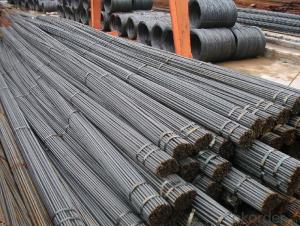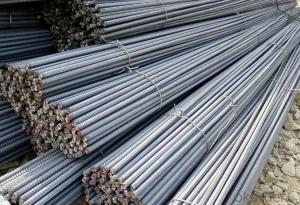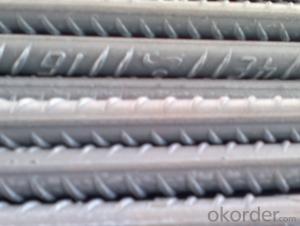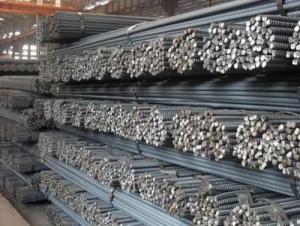Steel Rebar, Deformed Steel Bar, Iron Rods For Construction/Concrete Material
- Loading Port:
- Tianjin
- Payment Terms:
- TT or LC
- Min Order Qty:
- 30 m.t.
- Supply Capability:
- 40000 m.t./month
OKorder Service Pledge
OKorder Financial Service
You Might Also Like
Product Description:
OKorder is offering Steel Rebar, Deformed Steel Bar, Iron Rods For Construction/Concrete Material at great prices with worldwide shipping. Our supplier is a world-class manufacturer of steel, with our products utilized the world over. OKorder annually supplies products to European, North American and Asian markets. We provide quotations within 24 hours of receiving an inquiry and guarantee competitive prices.
Product Applications:
Steel Rebar, Deformed Steel Bar, Iron Rods For Construction/Concrete Material are ideal for structural applications and are widely used in the construction of buildings and bridges, and the manufacturing, petrochemical, and transportation industries.
Product Advantages:
OKorder's Steel Rebar, Deformed Steel Bar, Iron Rods For Construction/Concrete Material are durable, strong, and resist corrosion.
Main Product Features:
· Premium quality
· Prompt delivery & seaworthy packing (30 days after receiving deposit)
· Corrosion resistance
· Can be recycled and reused
· Mill test certification
· Professional Service
· Competitive pricing
Product Specifications:
Deformed bars/reinforced bars:
1.Material:GB--HRB400/HRB500 ; BS4449--460B/500B;
ASTM A615-Gr40/60 ; AS4671--500N/500E;
JISG3112--SD400 ; DIN488-1--BST500S;
KS-SD390.
2.Standard.:ASTM/JIS/DIN/BS/GB/KS.
3.Diameter:6-50mm.
The Specification of Deformed Steel Bars
| THEORETICAL WEIGHT INDEX | ||
| SIZE(mm) | CUT AREA(cm2) | THEORETICAL WEIGHT(kg/m) |
| 8 | 0.503 | 0.395 |
| 9 | 0.636 | 0.5 |
| 10 | 0.79 | 0.62 |
| 12 | 1.13 | 0.89 |
| 14 | 1.54 | 1.21 |
| 16 | 2.01 | 1.58 |
| 18 | 2.55 | 2 |
| 20 | 3.14 | 2.47 |
| 22 | 3.8 | 2.98 |
| 25 | 4.91 | 3.85 |
| 28 | 6.16 | 4.83 |
| 32 | 8.04 | 6.31 |
| Grade | Technical data of the original chemical composition(%) | ||||||||
| C | Mn | Si | S | P | B | ||||
| HRB335 | ≤ 0.25 | ≤ 1.60 | ≤ 0.80 | ≤ 0.045 | ≤ 0.045 | >0.0008 | |||
| Physics capability | |||||||||
| Yield Strength(N/cm 2 ) | Tensile Strength(N/cm 2 ) | Elongation (%) | |||||||
| ≥ 335 | ≥ 490 | ≥ 16 | |||||||
| Grade | Technical data of the original chemical composition (%) | |||||
| C | Mn | Si | S | P | V | |
| HRB400 | ≤0.25 | ≤1.60 | ≤ 0.80 | ≤ 0.045 | ≤ 0.045 | 0.04-0.12 |
| Physics capability | ||||||
| Yield Strength ( N/cm 2 ) | Tensile Strength ( N/cm 2 ) | Elongation (%) | ||||
| ≥ 400 | ≥570 | ≥ 14 | ||||
FAQ:
Q1: Why buy Materials & Equipment from OKorder.com?
A1: All products offered byOKorder.com are carefully selected from China's most reliable manufacturing enterprises. Through its ISO certifications, OKorder.com adheres to the highest standards and a commitment to supply chain safety and customer satisfaction.
Q2: How do we guarantee the quality of our products?
A2: We have established an advanced quality management system which conducts strict quality tests at every step, from raw materials to the final product. At the same time, we provide extensive follow-up service assurances as required.
Q3: How soon can we receive the product after purchase?
A3: Within three days of placing an order, we will begin production. The specific shipping date is dependent upon international and government factors, but is typically 7 to 10 workdays.
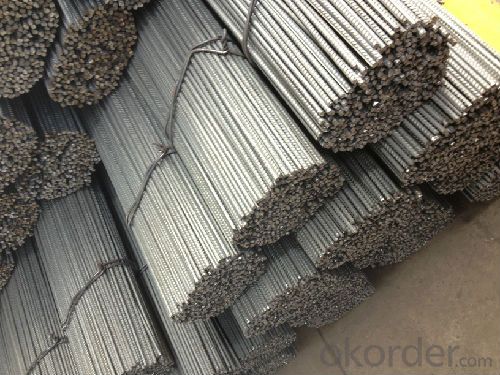
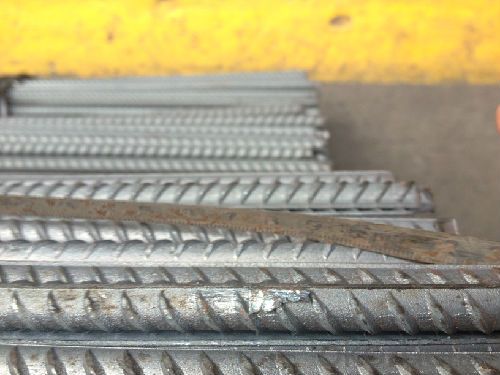
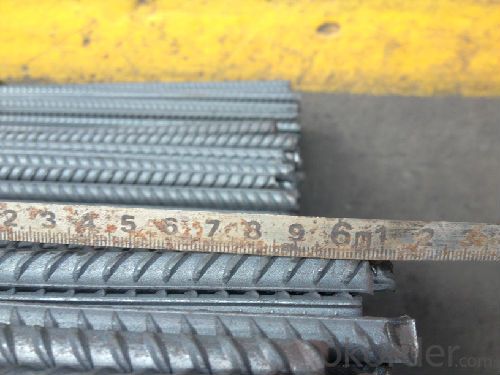
- Q:Are steel rebars easy to work with?
- Steel rebars can be challenging to work with due to their weight and rigidity, but with proper tools and techniques, they can be effectively manipulated and integrated into construction projects.
- Q:Can steel rebars be used in structures with limited foundation support?
- Yes, steel rebars can be used in structures with limited foundation support. Steel rebars are commonly used as reinforcement in concrete structures to enhance their strength and durability. In structures with limited foundation support, the steel rebars can help distribute the load more evenly throughout the structure, minimizing the stress on the foundation. Additionally, the use of steel rebars can also increase the overall stability of the structure. However, it is important to note that the design and placement of the rebars should be done by a qualified engineer to ensure that they are properly integrated into the structure and can effectively bear the load.
- Q:How are steel rebars used in the construction of power plants?
- Steel rebars are commonly used in the construction of power plants due to their strength and durability. These reinforced steel bars are used to provide structural support and reinforcement to various concrete elements in the power plant construction. One of the primary applications of steel rebars in power plant construction is in the construction of foundations and structural members. Power plants require strong and stable foundations to support the heavy equipment and machinery, as well as withstand the dynamic loads and vibrations. Steel rebars are embedded within the concrete foundation to enhance its structural integrity and resistance to compressive and tensile forces. In addition to foundations, steel rebars are also used in the construction of walls, columns, and beams in power plants. These elements play a crucial role in supporting the overall structure and ensuring its stability. By adding steel rebars to the concrete mix, the resulting reinforced concrete components can bear higher loads and resist cracking or deformation under stress. Furthermore, steel rebars are utilized in the construction of containment structures in nuclear power plants. These structures are designed to confine any potential release of radioactive materials in case of accidents or incidents. By incorporating steel rebars into the concrete walls and floors of these containment structures, their strength and resistance to impact and penetration are significantly enhanced, thereby improving the safety and security of the power plant. Overall, steel rebars play a vital role in the construction of power plants by providing reinforcement to concrete elements and ensuring the structural integrity and longevity of the facility. Their use enhances the strength, durability, and safety of the power plant, making it capable of withstanding various operational and environmental conditions.
- Q:How do steel rebars affect the overall construction cost of industrial buildings?
- Steel rebars can have a significant impact on the overall construction cost of industrial buildings. Rebars are used as reinforcement in concrete structures, providing strength and durability. The amount of steel rebars required in a building project directly affects the cost, as the price of steel is a major component of the overall construction expenses. Firstly, the quantity of rebars needed depends on the size, design, and complexity of the industrial building. Larger buildings or those with intricate architectural features may require a higher number of rebars, resulting in increased costs. Additionally, the design and engineering requirements for seismic or wind resistance can also influence the quantity of rebars, further impacting the construction budget. Moreover, the quality and grade of the steel rebars used can affect the cost. Higher-grade rebars, such as those with higher tensile strength or corrosion resistance, may be more expensive. However, using higher-grade rebars can provide long-term benefits by enhancing the structural integrity of the building and reducing maintenance and repair costs over its lifespan. Transportation and handling costs also contribute to the overall cost. Steel rebars are heavy and bulky, requiring careful handling and transportation to the construction site. The distance between the steel supplier and the site can significantly impact transportation costs. Additionally, the storage and protection of rebars on-site must be considered to ensure their quality, which may involve additional expenses. Lastly, labor costs associated with the installation of steel rebars should be taken into account. Skilled labor is required to correctly place and tie the rebars according to design specifications and building codes. The complexity of the reinforcement design can affect the time required for installation, ultimately influencing labor costs. In conclusion, steel rebars play a vital role in the construction of industrial buildings by reinforcing concrete structures. The quantity, quality, transportation, and labor costs associated with steel rebars directly impact the overall construction cost. Therefore, careful planning and consideration of these factors are necessary to effectively manage the budget of industrial building projects.
- Q:Are there any health and safety concerns related to steel rebars?
- Yes, there are several health and safety concerns related to steel rebars. Firstly, handling and lifting steel rebars can pose risks of musculoskeletal injuries such as strains, sprains, and back injuries. These rebars are heavy and often require manual handling or the use of heavy machinery, which can increase the risk of accidents and injuries. Secondly, steel rebars are often coated with chemicals to prevent corrosion. These coatings can contain hazardous substances such as toxic metals or volatile organic compounds (VOCs). Exposure to these chemicals through inhaling fumes or direct contact with the skin can lead to health issues, including respiratory problems, skin irritation, and chemical burns. Furthermore, steel rebars are commonly used in construction sites, which can be hazardous environments. Workers may face risks of falling rebars, tripping over them, or being struck by them. Additionally, improper installation or positioning of steel rebars can compromise the structural integrity of the construction, potentially leading to accidents or collapses. To mitigate these health and safety concerns, it is important to provide appropriate training and personal protective equipment (PPE) to workers handling steel rebars. Employers should also enforce proper lifting techniques and safe work practices to prevent musculoskeletal injuries. Adequate ventilation systems and the use of respiratory protection can help in reducing exposure to hazardous chemicals. Lastly, regular inspections and adherence to construction regulations can ensure the proper placement and installation of steel rebars, minimizing the risk of accidents and structural failures.
- Q:What is the maximum tensile force of 25 thread steel?
- The maximum tensile force is the first to know that the thread steel belongs to several grades of steel; the tensile strength is x, and the cross sectional area is the maximum tensile force.Tensile strength of thread steel of 25 diameter = tensile strength of the grade steel, x, sectional area =41000, Newton, ~61000, Newton=4100kgf~6100kgf.
- Q:What is the maximum allowable diameter for steel rebars?
- The maximum allowable diameter for steel rebars varies depending on the specific construction project and design specifications. However, commonly used steel rebars typically range from 6mm to 50mm in diameter.
- Q:What are the limitations of using steel rebars?
- One limitation of using steel rebars is their susceptibility to corrosion. Over time, exposure to moisture and chemicals can cause the steel rebars to rust, which weakens their structural integrity. Additionally, steel rebars are heavy and can be difficult to handle and transport, especially in large construction projects. Lastly, steel rebars have a high thermal conductivity, which can lead to temperature changes causing expansion and contraction, potentially resulting in cracks or damage to the surrounding concrete.
- Q:What is the process of testing the quality of steel rebars?
- The process of testing the quality of steel rebars involves several steps to ensure their compliance with industry standards and specifications. 1. Visual Inspection: This initial step involves a visual examination of the rebars to identify any visible defects, such as cracks, surface irregularities, or improper dimensions. 2. Chemical Composition Analysis: A sample of the steel rebars is taken and subjected to chemical analysis to determine its composition, including the percentage of carbon, manganese, sulfur, phosphorus, and other elements. This analysis ensures that the steel meets the required composition standards for strength and durability. 3. Tensile Strength Test: A tensile strength test is conducted to measure the maximum amount of stress that the steel rebars can withstand without deformation or failure. This is achieved by applying a gradually increasing load to a sample of the rebar until it breaks. The tensile strength is then determined by dividing the breaking load by the cross-sectional area of the sample. 4. Bend Test: In the bend test, a sample of the rebar is bent to a specified angle without any cracks or fractures occurring. This test evaluates the rebar's ductility, which is crucial for its ability to withstand bending and shaping during construction. 5. Weldability Test: If the steel rebars are intended for use in welded structures, a weldability test is performed. This test assesses the ability of the rebars to be welded without any issues, such as cracking or loss of strength. 6. Dimensional and Weight Inspection: The rebars are measured for their dimensions, including length, diameter, and weight, to ensure compliance with the required specifications. Any deviations may indicate a potential quality issue. 7. Corrosion Resistance Test: Steel rebars are often exposed to harsh environmental conditions, including moisture and corrosive substances. Therefore, a corrosion resistance test is conducted to evaluate the rebar's ability to withstand corrosion over time. This test is typically carried out by subjecting the rebars to a corrosive environment or by using accelerated corrosion testing methods. 8. Non-Destructive Testing (NDT): NDT techniques, such as ultrasonic testing, magnetic particle inspection, or radiographic testing, may be employed to detect any internal defects or irregularities that are not visible to the naked eye. These tests help ensure the integrity and quality of the rebars. 9. Certification and Documentation: Once all the tests are completed and the steel rebars meet the required standards, they are certified and documented accordingly. This documentation serves as evidence of the quality and compliance of the rebars and is crucial for construction projects to ensure safety and durability. By following these comprehensive testing procedures, the quality of steel rebars can be thoroughly assessed, providing assurance to builders, engineers, and end-users that the steel rebars meet the necessary quality standards for their intended applications.
- Q:Can steel rebars be used in high-rise construction projects?
- Yes, steel rebars can definitely be used in high-rise construction projects. In fact, they are widely used in the construction industry for their strength and durability. Steel rebars are typically used in reinforced concrete structures, including high-rise buildings, to provide tensile strength and reinforce the concrete against cracking or failure. The use of steel rebars in high-rise construction projects helps to ensure the structural integrity and stability of the building. Additionally, steel rebars allow for flexibility in design and can be easily customized to meet the specific requirements of each project. Overall, steel rebars are an essential component in high-rise construction and play a crucial role in ensuring the safety and longevity of these structures.
1. Manufacturer Overview |
|
|---|---|
| Location | |
| Year Established | |
| Annual Output Value | |
| Main Markets | |
| Company Certifications | |
2. Manufacturer Certificates |
|
|---|---|
| a) Certification Name | |
| Range | |
| Reference | |
| Validity Period | |
3. Manufacturer Capability |
|
|---|---|
| a)Trade Capacity | |
| Nearest Port | |
| Export Percentage | |
| No.of Employees in Trade Department | |
| Language Spoken: | |
| b)Factory Information | |
| Factory Size: | |
| No. of Production Lines | |
| Contract Manufacturing | |
| Product Price Range | |
Send your message to us
Steel Rebar, Deformed Steel Bar, Iron Rods For Construction/Concrete Material
- Loading Port:
- Tianjin
- Payment Terms:
- TT or LC
- Min Order Qty:
- 30 m.t.
- Supply Capability:
- 40000 m.t./month
OKorder Service Pledge
OKorder Financial Service
Similar products
New products
Hot products
Hot Searches
Related keywords
